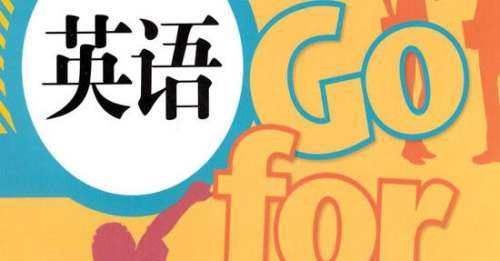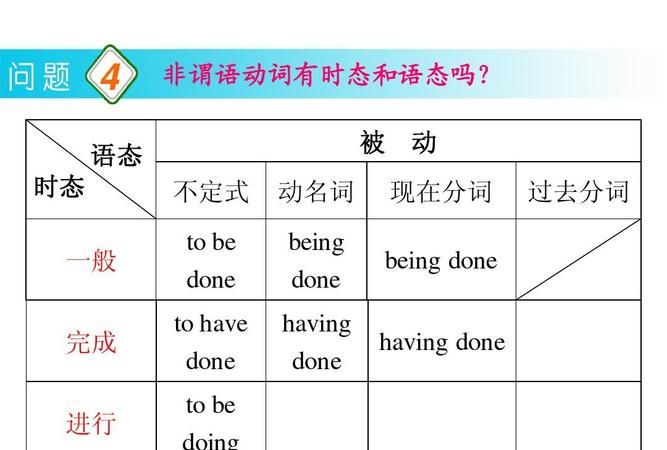本文目录
高中非谓语动词知识点详解
非谓语动词的语法知识点详解
在句子中充当除谓语以外的句子成分的动词形式叫作非谓语动词。非谓语动词分为三种形式∶动名词,不定式和分词﹙包括现在分词和过去分词﹚
非谓语动词与其他动词的不同点:
1.非谓语动词可以有名词作用(如动词不定式和动名词),在句中做主语、宾语、表语。
2.非谓语动词可以有形容词作用(如动词不定式和分词),在句中做定语、表语或宾语补足语。
3.非谓语动词可以有副词作用(如动词不定式和分词),在句中作状语。
4.谓语动词在句中作谓语,受主语的人称和数的限制;非谓语动词在句中不能单独作谓语,它不受主语的人称和数的限制。
(5)英语中不能单独做句子的谓语。
非谓语动词分类:
不定式、动名词和分词作表语的区别
不定式作表语一般表示具体动作,特别是表示将来的动作。
不定式和动名词作宾语的区别
begin开始 determine决定 manage设法 agree同意 love 喜欢 fail不能 plan计划
(2)有少数动词只能用动名词作宾语
acknowledge承认,admit 承认 dislike不喜欢,讨厌 advocate:提倡,主张 complete完成
appreciate 感激,欣赏 avoid避免 enjoy享有,喜爱 delay延迟 escape逃跑,逃避 deny否认
consider 考虑 fancy幻想,爱好 mind 介意 miss错过 finish完成,结束不得 resist抵抗,阻止 imagine设想 postpone延迟,延期 practise 实行,实践 suggest建议 prevent阻止
keep保持 quit放弃停止 loathe非常讨厌,厌恶 recall回想
不定式和动名词作主语的区别
(1)动名词作主语时,通常用以表示一件已知的事或经验。不定式短语通常用来表示一件未完成的事或目的。例如:
Driving a car during the rush hour is tiring.在高峰时刻开车令人厌烦。
(2)不定式做主语,一般用it当形式主语,把作主语的不定式短语后置。例如:
It took me only five minutes to finish the job.
不定式、现在分词和过去分词作定语的区别
The child standing over there is my brother.站在那儿的男孩子是我弟弟。
不定式和分词作状语的区别
1)现在分词作状语时,现在分词的动作就是句子主语的动作,它们之间的关系是主动关系。
2)过去分词作状语时,过去分词表示的动作是句子主语承受的动作,它们之间的关系是被动关系。
Given more attention, the trees could have grown better.
非谓语动词常考的其它结构
(1)疑问词+不定式结构
疑问词who,what,which,when,where和how后加不定式可构成一种特殊的不定式短语。它在句中可以用作主语、宾语、表语和双重宾语。
(2)不带to的不定式
在表示生理感觉的动词后的不定式不带to。
这类词有: feel 觉得 observe 注意到,看到 overhear听到 watch注视 listen to听 perceive察觉,感知 notice注意 see看见 look at看 hear听

新概念英语非谓语动词之不定式语法讲解视频
新概念英语非谓语动词之不定式语法讲解
1.定义:具有名词、形容词及副词性质并具有时态、语态变化。

2.形式:(以do为例)
主动语态 被动语态
一般时 to do to be done
进行时 to be doing
完成时 to have done to have been done
完成进行时 to have been doing
3.用法:
(1)用作主语:
To speak good English is not easy.
or: It is not easy to speak good English.
(采用形式主语 it 以避免头重脚轻)
It took me an hour to do the work.
(2)用作宾语:
She decided to take the examination.
I hope to meet him soon.
(3)宾语补足语:
They expected us to help them.
He wants his son to study hard.
金牌重点:
不定式作宾补,如谓语动词是感官动词,使役性动词(see, hear, notice, watch, make, have, let...),则不定式符号“to”须省略,但在被动语态中不能省。
I heard them sing in the classroom.
I made her clean the room.
The girl is heard to sing an English song.
(4)用作表语:
To teach is to learn.
His job is to sell cars.
(5)用作状语,表示目的',结果:
We come to school to study English.(目的)
= in order to
I hurried to the store, only to find it closed.(结果)
(6)定语:不定式短语作定语须位于名词之后。
He asked for a piece of paper to write it on.
= to write it on the piece of paper.
The poor man has no house to live in.
= to live in the house.
Have you anything to do?
= to do anything
4.不定式的时态意义:
She seems to dance very well.(现在情况)
She seems to be dancing in the dancing hall.(正在进行)
She seems to have danced well.(过去情况)
Has was happy to have been staying with his uncle.(动作持续一段时间)
5.不定式语态:
The doctor [wrecommend]recommended[/w] him to air the room.
The doctor recommended the room to be aired.
She expects the police to find her bicycle.
She expects her bicycle to be found by the police.
She felt a bit puzzled as he had asked her such a question.
She felt a bit puzzled to have been asked such a question.
6.不定式否定形式:not to do ...
He got up early in order not to miss the train.
测试精编
1. Did you find out ________ the pie out of oven?
A. to take B. have taken C. when to take D. being taken
2. You would be irritated if you watched the mail ________ on your desk every day.
A. putting up B. to be put up C. to pile up D. pile up
3. We shall set Jim ________ the passage.
A. explaining B. explained C. to explain D. explain
4. In fact, she would rather leave for San Francisco ________ in Los Angeles.
A. tostay B. than stay C. than staying D. than have stayed
5. Madame Curies is believed ________ the radium.
A. discovering B. having discovered C. to have discovered D. to discover
(后设答案,大家不要偷看哦~(*^__^*) 嘻嘻……)
KEYS
1. C 2. D 3. C 4. B 5. C
;非谓语动词的三种形式及用法例句
非谓语动词详析 非谓语动词在句子中不作谓语,它包含动词不定式,动名词,分词。 动词不定式是动词的一种非限定形式,由“to+动词原形”构成,在句子中起名词,形容词或副词的作用。在句子中可以充当各种成分,有多种用法。 Ⅰ、不定式完成式的用法:如果不定式所表示的动作在谓语动作发生之前,不定式要用完成式(to have done)。 For example :I’m sorry not to have come on Wednesday .(我星期三没能来到,很抱歉)。 不定式的完成式只用于下列情况: a、 在seem(似乎),appear(显得),be supposed(被认为),be said(听说)等动词后,表示在更早时间发生的事。 For example: He seems to have been ill.(他现在看起来好像生过一场病) b、 be wish(想),hope(希望),desire(欲望),intend(打算),suppose(料想),think(想)等动词的“过去式+不定式的完成式”。表示没有实现的时间。For example: I wished to have helped you , but I had no money.(我本来愿意帮助你,但当时没有钱) He meant to have come to see you last night.(昨天晚上他本来有意来看你) Ⅱ、不定式的被动式及用法。当不定式的逻辑主语为不定式所表示动作的承受者时,就用不定式的被动式(to be done, to have been done). For example: I want the letter to be typed at once.(我要求这信马上打出来) It’s an honor for me to be invited to your house.(能被邀请到你们家是一种荣耀) Ⅲ、 主动的不定式与被动的不定式的区别及用法 1、通常,在不定式前能找到不定式所表达的动作的执行者时,此不定式用主动形式,每当不定式前不能找到所表达的动作的执行着时,此不定式用被动形式。 I have work to do (不能说I have work to be done)我有工作要干(执行者:I) He is reading the report to be published tomorrow 他正在阅读那份明天要发表的报告。(publish前无执行者) 2、在“there be”结构中,既可用主动式也可用被动式。 Example: There is no time to lose(to be lost) 再也不能耽搁时间了。 虽然在该结构中,作定语的不定式可以用主动形式,也可以用被动形式,但这两种形式还是有差别的。 1、There are a number of problems to solve. 2、There are a number of problems to be solved. 例句1中用的是动词不定式的主动形式,不定式的逻辑主语可以从上下问中看出来。假设逻辑主语是we,那么例如1可以改写成:There are a number of problems that we must solve.例如2中的动词不定试是被动形式,可以改写成:There are a number of problems that must be solved.例句2中的不定式的逻辑主语从上下问看不出来。 Ⅳ、 不定式短语和动名词作主语的用法及区别 不定式短语和动名词短语作主语时,可以用it做形式主语,使用“it+位于+作主语的不定式(动名词)短语”句型,主要区别是;不定式一般表示具体的行为动作,动名词往往抽表示抽象概念,表达某个一般的动作,或表示说话者的亲身经历。 For example: Being polite is needed anytime and anywhere.任何时候在任何地点都需要有礼貌。 Ⅴ、 作插入语的独立不定式的用法 独立不定式和动词不定式不动,与句中其他部分没有语法关系,只作插入语用,对全句进行解释,表示说话人的态度或起承上启下的作用,独立不定式无论位于何处,它必须用逗号与句子隔开,常用的独立不定式有: To begin with首先,to tell the truth老实说 To be brief简而言之,to return to the subject言归正传 To make matters worse更糟的是,to make a long story short简言之 等。 Ⅵ、 不带to 的不定式的用法,动词不定试有带to和不带to两中形式,以下几种情况不能带to. 1、在情态动词will, shall, would, should, can, could, may, might和must之后,在would rather和had better之后,以及在作为主次的need, dare之后,不定式不带to. For example: I’d rather go alone.但愿自己去。 2、当不定式作see, hear, overhear, listen to, feel, observe, look at 等感官动词的宾语补足语时不带to For example: I’ve never observed her do otherwise.(我从未看见她不是这样做的). 3、当不定式作make, let, leave, have, bid等使役动词以及find, help, know等动词的宾语补足语 4、在某些习语和固定搭配中不定式不带to,常见的有: make believe假装, make do凑合,hear tell听说 5、介词but, except, besides, save等之前有动词do或do的其他形式以及can but(不得不)can not but(只得,只能),cannot help but(不得不) can not choose but(只好)等短语时,其它的不定式不带to. For example: I could not choose but speak the truth. 我不能不说真话。 动名词,动名词也是动词的一种非限定形式,由动词原形加“-ing”构成,与现在分词同形。动名词前有动词和名词的特征和作用。 Ⅰ、动名词的逻辑主语是代词时,用形容词性的物主代词表示有生命的名词时,用名词的“’s” 所有格;表示无生命的名词时,用名词的普通格,不用所有格。 For example: Mary’s grumbling annoyed him(名词的所有格) I am afraid of the tent falling down during the night(名词的普通格) 我不怕那个帐篷晚上倒下来。 Ⅱ、 介词后使用动名词的情况 A、介词后面的动词要用动名词形式,“介词+动名词”可以作状语,表示时间、原因、方式等,表示目的常用不定式或“for the purpose of doing something”结构。 For example I came here for the purpose of seeing you.(我来这儿是为了看你) B、“介词to+动名词”和“不定式to+动词原形”的区别 若to是介词,其后只能接动名词。 For example: I’ve been looking forward to seeing you soon.(我期望早日见到你)。 Ⅲ、动名词用于“It is no use (good) doing…”等句型 动名词作主语时,也可以用it做先行主语。动名词(短语)常在以 no use, no good, senseless, dangerous, difficult, a waste, a nuisance, useless, hard work, sad thing, a waste of time, worthwhile等词语作表语的句中。 For example: It is a mere waste of time answering these letters.(回复这些信笺,只不过是浪费时间而已) Ⅳ、动词后跟动名词和跟不定式的比较。 在advise, allow, attempt, can’t bear, begin, continue, forbid, forget, go on, hate,hear,intend,like,love,permit,prefer,propose,regret,remember,see,start,stop,try,watch等动词后面,既可以跟不定式,也可跟动名词,但意思有区别。 分词。分词是动词的三中非限定形式之一,分为两种:现在分词和过去分词。 Ⅰ、现在分词和过去分词作定语的区别:分词作定语时,应注意它与被修饰的动词之间的关系。如果是被修饰名词发出的动作,须用现在分词,如果被修饰的名词是动作的接受者,则用过去分词。因此现在分词带有主动和未完成的意义,过去分词带有被动和完成的意义。 The crying child woke her mother.(啼哭的孩子唤醒了她妈妈。)child是动作cry的发出者。 The sorted letters were delivered to the houses.(分了类的信件被送往各家各户)letters是动作sorted的接受者。 Ⅱ、分词独立结构,分词短语用作状语的时候,它的逻辑主语一般必须与句子的主语一直。但是它有时也可以有自己逻辑上的主语,形成“名词(代词)+分词(或分词短语)”结构。这种带有逻辑主语分词或分词短语成为分词独立结构。这种结构有的接近同位语,对前面的一个名词加以解释。 For example: There are two good books, each having it’s own characteristics.有两本好书,每本都有各自的特点。 Ⅲ、分词和不定式作定语的区别 A、 现在分词作定语表示正在进行的动作及现在(或当时)的状态。例如:The girl playing the piano is Mary.正在弹钢琴的女孩叫Mary. B、过去分词作定语表示的动作在谓语动作之前发生或是没有一定的时间性,有被动之意。 For example: The piano used at the concert is made in France.音乐会上用的钢琴是法国产的。 C、不定式作定语表示一个未来的动作。 For example: The girl to play the piano at the concert is Mary.将要在音乐会上弹钢琴的女孩叫Mary。

主谓一致和非谓语动词
在英语中,不作句子谓语,而具有除谓语外其他语法功能的动词,叫做非谓语动词。非谓语动词有动词不定式(the Infinitive);动名词(the Gerund);现在分词(the Present Participle);过去分词(the Past Participle)。
1.非谓语动词与谓语动词的相同点有:
(1)如果是及物动词都可与宾语连用,例如:
They built a garden.
They suggested building a garden.
(2)都可以被状语修饰:
The suit fits him very well.
The suit used to fit him very well.
(3)都有主动与被动, “体”式(一般式;进行式;完成式)的变化。例如:
He was punished by his parents.(谓语动词被动语态)
He avoided being punished by his parents.(动名词的被动式)
We have written the composition.(谓语动词的完成时)
Having written the composition, we handed it in.(现在分词的完成式)
(4)都可以有逻辑主语
They started the work at once.(谓语动词的逻辑主语)
The boss ordered them to start the work.(动词不定式的逻辑主语)
We are League members.(谓语动词的主语)
We being League member, the work was well done.
(现在分词的逻辑主语)
2、非谓语动词与谓语动词的不同点有:
(1)非谓语动词可以有名词作用(如动词不定式和动名词),在句中做主语、宾语、表语。
(2)非谓语动词可以有形容词作用(如动词不定式和分词),在句中做定语、表语或宾语补足语。
(3)非谓语动词可以有副词作用(如动词不定式和分词),在句中作状语。
(二)非谓语动词的句法功能:
二、非谓语动词用法:
(一)动词不定式:(to)+do,具有名词、形容词、副词的特征。
1.不定式的形式:(以动词write为例)
否定式:not + (to) do
(1)一般式:不定式的一般式所表示的动作与谓语动词动作同时发生或发生在谓语动词动作之后,
例如:
I'm glad to meet you.
He seems to know a lot.
We plan to pay a visit.
He wants to be an artist.
The patient asked to be operated on at once.
The teacher ordered the work to be done.
(2)进行式:不定式的进行式所表示的动作与谓语动词动作同时发生,例如:
The boy pretended to be working hard.
He seems to be reading in his room.
(3)完成式:不定式的完成式表示的动作发生在谓语动词动作之前,例如:
I regretted to have told a lie.
I happened to have seen the film.
He is pleased to have met his friend.
2.不定式的句法功能:
(1)作主语:
To finish the work in ten minutes is very hard.
To lose your heart means failure.
动词不定式短语作主语时,常用it作形式主语,例如上面两句可用如下形式:
It is very hard to finish the work in ten minutes.
It means failure to lose your heart.
(2)作表语:
Her job is to clean the hall.
He appears to have caught a cold.
(3)作宾语:
常与不定式做宾语连用的动词有:want, hope, wish, offer, fail, plan, learn, pretend, refuse, manage, help, agree, promise, prefer, 如果不定式(宾语)后面有宾语补足语,则用it作形式宾语,真正的宾语(不定式)后置,放在宾语补足语后面,例如:
Marx found it important to study the situation in Russia.
动词不定式也可充当介词宾语,如:
I have no choice but to stay here.
He did nothing last Sunday but repair his bike.
动词不定式前有时可与疑问词连用,如:
He gave us some advice on how to learn English.
(4)作宾语补足语:
在复合宾语中,动词不定式可充当宾语补足语,如下动词常跟这种复合宾语:want, wish, ask, tell, order, beg, permit, help, advise, persuade, allow, prepare, cause, force, call on, wait for, invite.
此外,介词有时也与这种复合宾语连用,如:
With a lot of work to do, he didn't go to the cinema.
有些动词如make, let, see, watch, hear, feel, have等与不带有to的不定式连用,但改为被动语态时,不定式要加to, 如:
I saw him cross the road.
He was seen to cross the road.
(5)作定语:
动词不定式作定语,放在所修饰的名词或代词后。与所修饰名词有如下关系:
①动宾关系:
I have a meeting to attend.
注意:不定式为不及物动词时,所修饰的名词如果是地点、工具等,应有必要的介词,如:
He found a good house to live in.
The child has nothing to worry about.
What did you open it with?
如果不定式修饰time, place, way,可以省略介词:
He has no place to live.
This is the best way to work out this problem.
如果不定式所修饰名词是不定式动作承受者,不定式可用主动式也可用被动式:
Have you got anything to send?
Have you got anything to be sent?
②说明所修饰名词的内容:
We have made a plan to finish the work.
③被修饰名词是不定式逻辑主语:
He is the first to get here.
(6)作状语:
①表目的:
He worked day and night to get the money.
She sold her hair to buy the watch chain.
注意不定式放句首时,逻辑主语与句子主语要一致:
wrong:To save money, every means has been tried.
right:To save money, he has tried every means.
wrong:To learn English well, a dictionary is needed.
right:To learn English well, he needs a dictionary.
②表结果:
He arrived late to find the train gone.
常用only放在不定式前表示强调:
I visited him only to find him out.
③表原因:
They were very sad to hear the news.
④表程度:
It's too dark for us to see anything.
The question is simple for him to answer.
(7)作独立成分:
To tell you the truth, I don't like the way he talked.
(8)不定式的省略:保留to省略do动词。
If you don't want to do it, you don't need to.
(9)不定式的并列:第二个不定式可省略to。
He wished to study medicine and become a doctor.
(二)动名词:
动名词既具有动词的一些特征,又具有名词的句法功能。
1.动名词的形式:
否定式:not + 动名词
(1)一般式:
Seeing is believing. 眼见为实。
(2)被动式:
He came to the party without being invited.他未被邀请就来到了晚会。
(3)完成式:
We remembered having seen the film. 我们记得看过这部电影。
(4)完成被动式:
He forgot having been taken to Guangzhou when he was five years old.
他忘记五岁时曾被带到广州去过。
(5)否定式:not + 动名词
I regret not following his advice. 我后悔没听他的劝告。
(6)复合结构:物主代词(或名词所有格)+ 动名词
He suggested our trying it once again. 他建议我们再试一次。
His not knowing English troubled him a lot.
他不懂英语给他带来许多麻烦。
2.动名词的句法功能:
(1)作主语:
Reading aloud is very helpful. 朗读是很有好处的。
Collecting stamps is interesting. 集邮很有趣。
当动名词短语作主语时常用it作形式主语。
It's no use quarrelling.争吵是没用的。
(2)作表语:
In the ant city, the queen's job is laying eggs.
在蚂蚁王国,蚁后的工作是产卵。
(3)作宾语:
They haven't finished building the dam. 他们还没有建好大坝。
We have to prevent the air from being polluted.
我们必须阻止空气被污染。
注意动名词既可作动词宾语也可作介词宾语,如上面两个例句。此外,动名词作宾语时,若跟有宾语补足语,则常用形式宾语it,例如:
We found it no good making fun of others. 我们发现取笑他人不好。
要记住如下动词及短语只跟动名词作宾语:
enjoy, finish, suggest, avoid(避免), excuse ,delay, imagine, keep, miss, consider, admit(承认),deny(否认), mind, permit, forbid, practise, risk(冒险), appreciate(感激), be busy, be worth, feel like, can't stand, can't help(情不自禁地), think of, dream of, be fond of, prevent…(from),keep …from, stop…(from),protect…from, set about, be engaged in, spend…(in), succeed in, be used to, look forward to, object to, pay attention to, insist on, feel like
(4)作定语:
He can't walk without a walking-stick. 他没有拐杖不能走路。
Is there a swimming pool in your school? 你们学校有游泳池吗?
(5)作同位语:
The cave, his hiding-place is secret. 那个山洞,他藏身的地方很秘密。
His habit, listening to the news on the radio remains unchanged.
他收听收音机新闻节目的习惯仍未改变。
(三)现在分词:
现在分词既具有动词的一些特征,又具有形容词和副词的句法功能。
1、现在分词的形式:
否定式:not + 现在分词
(1)现在分词的主动语态:现在分词主动语态的一般式表示与谓语动词所表示的动作同时发生,完成
式表示的动作在谓语动词所表示的动作之前发生,常作状语。例如:
They went to the park, singing and talking. 他们边唱边说向公园走去。
Having done his homework, he played basket-ball. 做完作业,他开始打篮球。
(2)现在分词的被动语态:一般式表示与谓语动词同时发生的被动的动作,完成式表示发生在谓语动
词之前的被动的动作。
The problem being discussed is very important. 正在被讨论的问题很重要。
Having been told many times, the naughty boy made the same mistake.
被告诉了好几遍,这个淘气的孩子又犯了同一个错误。
2.现在分词的句法功能:
(1)作定语:现在分词作定语,当分词单独做定语时,放在所修饰的名词前;如果是分词短语做定语
放在名词后。
In the following years he worked even harder.
在后来的几年中,他学习更努力了。
The man speaking to the teacher is our monitor's father.
正与老师谈话的那个人是我们班长的父亲。
现在分词作定语相当于一个定语从句的句法功能,如:in the following years也可用in the years that followed; the man speaking to the teacher可改为the man who is speaking to the teacher.
(2)现在分词作表语:
The film being shown in the cinema is exciting. 正在这家上演的电影很棒。
The present situation is inspiring. 当前的形势鼓舞人心。
be + doing既可能表示现在进行时,也可能是现在分词做表语,它们的区别在于be + doing表示进行的动作是进行时,而表示特征时是系动词be与现在分词构成系表结构。
(3)作宾语补足语:
如下动词后可跟现在分词作宾语补足语:
see, watch, hear, feel, find, get, keep, notice, observe, listen to, look at, leave, catch等。例如:
Can you hear her singing the song in the next room? 你能听见她在隔壁唱歌吗?
He kept the car waiting at the gate. 他让小汽车在门口等着。
(4)现在分词作状语:
①作时间状语:
(While) Working in the factory, he was an advanced worker.
在工厂工作时,他是一名先进工人。
②作原因状语:
Being a League member, he is always helping others. 由于是共青团员,他经常帮助他人。
③作方式状语,表示伴随:
He stayed at home, cleaning and washing. 他呆在家里,又擦又洗。
④作条件状语:
(If) Playing all day, you will waste your valuable time.
要是整天玩,你就会浪费宝贵的时间。
⑤作结果状语:
He dropped the glass, breaking it into pieces. 他把杯子掉了,结果摔得粉碎。
⑥作目的状语:
He went swimming the other day. 几天前他去游泳了。
⑦作让步状语:
Though raining heavily, it cleared up very soon.
虽然雨下得很大,但不久天就晴了。
⑧与逻辑主语构成独立主格:
I waiting for the bus, a bird fell on my heard.
我等汽车时,一只鸟落到我头上。
All the tickets having been sold out, they went away disappointedly.
所有的票已经卖光了,他们失望地离开了。
Time permitting, we'll do another two exercises.
如果时间允许,我们将做另两个练习。
有时也可用with (without) +名词(代词宾格)+分词形式
With the lights burning, he fell asleep. 他点着灯睡着了。
⑨作独立成分:
udging from(by) his appearance, he must be an actor.
从外表看,他一定是个演员。
Generally speaking, girls are more careful. 一般说来,女孩子更细心。
(四)过去分词:
过去分词只有一种形式:规则动词由动词原形加词尾-ed构成。不规则动词的过去分词没有统一的规则要求,要一一记住。
过去分词的句法功能:
1.过去分词作定语:
Our class went on an organized trip last Monday. 上周一我们班开展了一次有组织的旅行。
Those elected as committee members will attend the meeting. 当选为委员的人将出席这次会。
注意当过去分词是单词时,一般用于名词前,如果是过去分词短语,就放在名词的后面。过去分词做定语相当于一个被动语态的定语从句。
2.过去分词作表语:
The window is broken. 窗户破了。
They were frightened at the sad sight. 他们对眼前悲惨的景象感到很害怕。
注意:be + 过去分词,如果表示状态是系表结构,如果表示被动的动作是被动语态。区别:
The window is broken.(系表)
The window was broken by the boy.(被动)
有些过去分词是不及物动词构成的,不表示被动,只表示完成。如:
boiled water(开水) fallen leaves(落叶)
newly arrived goods(新到的货) the risen sun(升起的太阳)
the changed world(变了的世界)
这类过去分词有:gone, come, fallen, risen, changed, arrived, returned, passed等。
3.过去分词作宾语补足语:
I heard the song sung several times last week.
上周我听见这首歌被唱了好几次。
有时过去分词做with短语中的宾语补足语:
With the work done, they went out to play. 工作做完了,他们出去玩去了。
4.过去分词作状语:
Praised by the neighbours, he became the pride of his parents.
受到邻居们的表扬,他成为父母的骄傲。(表示原因)
Once seen, it can never be forgotten.
一旦它被看见,人们就忘不了。(表示时间)
Given more time, I'll be able to do it better.
如果给予更多的时间,我能做得更好。(表示条件)
Though told of the danger, he still risked his life to save the boy.
虽然被告之有危险,他仍然冒生命危险去救那个孩子。(表示让步)
Filled with hopes and fears, he entered the cave. 心中充满了希望与恐惧,他走进山洞。
参考资料:***/course/40430/YY_22_02_012/

以上就是关于初中非谓语动词语法讲解ppt ,高中非谓语动词知识点详解的全部内容,以及初中非谓语动词语法讲解ppt 的相关内容,希望能够帮到您。
